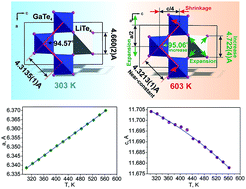Negative thermal expansion and electronic structure variation of chalcopyrite type LiGaTe2†
Abstract
The LiGaTe2 crystals up to 5 mm in size were grown by the modified Bridgman–Stockbarger technique and the cell parameter dependence on temperature in the range of 303–563 K was evaluated by the X-ray diffraction analysis. The thermal behavior of LiGaTe2 is evidently anisotropic and a negative thermal expansion is found along crystallographic direction c with coefficient −8.6 × 10−6. However, the normal thermal expansion in two a directions with coefficient 19.1 × 10−6 is dominant providing unit cell volume increase on heating. The atomic mechanism is proposed to describe this pronounced anisotropic expansion effect. The electronic structure of LiGaTe2 is measured by X-ray photoelectron spectroscopy and the band structure is obtained by DFT calculations. The pressure response from 0 to 5 GPa was calculated and a normal crystal compression is found. This work indicates that LiGaTe2 is promising as an IR NLO or window material for many practical applications because the thermal expansion coefficients of this telluride are not big. We believe that these results would be beneficial for the discovery and exploration of new IR optoelectronic polyfunctional metal tellurides.



 Please wait while we load your content...
Please wait while we load your content...